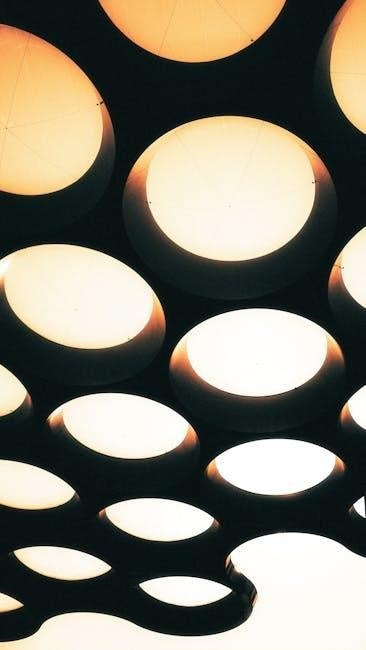Sustainable architectural design emphasizes harmony between built environments and nature, utilizing sun, wind, and light to create energy-efficient spaces, reducing environmental impact and promoting eco-friendly living.
The Importance of Sun, Wind, and Light in Building Design
The integration of sun, wind, and light in building design is essential for creating energy-efficient and sustainable structures. Solar energy provides natural heating and lighting, reducing the need for artificial systems. Wind acts as a natural cooling mechanism, enhancing ventilation and thermal comfort. Light optimizes daylighting, minimizing reliance on electric lighting. These elements not only lower energy consumption but also promote eco-friendly living. By understanding and applying these principles, architects can design buildings that harmonize with the environment, ensuring long-term sustainability and reduced environmental impact.
Overview of the Book “Sun, Wind, and Light: Architectural Design Strategies”

This book serves as a comprehensive guide for architects and designers, focusing on the integration of solar, wind, and light energies in building design. It explores how these natural elements can be harnessed to create sustainable and energy-efficient structures. The text emphasizes the form-generating potential of climatic forces, offering practical strategies for heating, cooling, and lighting buildings. Updated in its third edition, the book provides detailed insights, case studies, and design techniques, making it an invaluable resource for professionals aiming to incorporate eco-friendly principles into their work. It bridges theory and practice, inspiring innovative solutions for modern architectural challenges.
Understanding the Elements
The sun provides heat and light, influencing building orientation and material selection. Wind offers natural cooling through ventilation, while light enhances interior spaces and reduces energy consumption.
The Role of Solar Energy in Heating and Lighting
Solar energy plays a crucial role in sustainable design by providing natural heating and lighting. Buildings can be oriented to maximize sunlight during colder months, reducing the need for artificial heating. Passive solar heating techniques, such as using thermal mass materials, absorb and release heat. Daylighting strategies, like skylights and larger windows, reduce reliance on electric lighting. These approaches not only lower energy consumption but also create brighter, more comfortable interiors. The book emphasizes these techniques as cost-effective and environmentally friendly solutions for modern architecture. Solar integration is a cornerstone of sustainable design principles.
Wind as a Natural Cooling Mechanism

Wind serves as an essential natural cooling mechanism in sustainable design. By strategically orienting buildings and incorporating features like overhangs and louvers, architects can maximize airflow, reducing the need for air conditioning. Natural ventilation techniques, such as cross-ventilation and solar chimneys, enhance cooling efficiency. The book highlights how wind patterns influence building form and layout, promoting passive cooling strategies. These approaches not only lower energy consumption but also improve indoor air quality and occupant comfort. Harnessing wind effectively is a key principle in creating energy-efficient and environmentally responsive buildings.
Design Strategies for Energy Efficiency
Design strategies integrate sun, wind, and light to optimize energy performance. Techniques include passive solar heating, natural ventilation, and daylighting, enhancing sustainability and reducing energy consumption effectively.
Passive Solar Heating and Cooling Techniques
Passive solar techniques harness the sun’s energy for heating and cooling without mechanical systems. Strategic window placement captures winter sunlight for warmth and shades summer sun to reduce heat. Thermal mass materials absorb and release heat gradually, stabilizing indoor temperatures. Landscape design, such as planting trees, blocks summer solar radiation and allows winter sunlight. These methods reduce energy consumption and create comfortable living spaces naturally, aligning with sustainable architectural principles and environmental harmony.
Natural Ventilation and Daylighting Methods
Natural ventilation and daylighting maximize airflow and light without mechanical systems. Clerestory windows and skylights bring in sunlight, reducing artificial lighting needs. Cross-ventilation designs enhance airflow, cooling spaces naturally. Solar chimneys use thermal buoyancy to expel hot air, improving ventilation. Shading devices like overhangs and louvers control light entry, preventing overheating. These strategies create energy-efficient, comfortable environments while minimizing reliance on electrical systems, promoting sustainable design principles and enhancing indoor air quality. They align with the principles outlined in “Sun, Wind, and Light,” emphasizing harmony with natural elements.
Case Studies and Examples
Successful projects showcase buildings utilizing sun, wind, and light for energy efficiency. Notable examples highlight innovative designs that maximize natural elements, as detailed in the book.
Successful Buildings Utilizing Sun, Wind, and Light

Modern architecture showcases buildings that effectively harness natural elements. The book highlights structures designed to optimize solar heating, wind cooling, and daylighting. These examples demonstrate how integrating climatic forces enhances energy efficiency. Buildings like the Bullitt Center and the Edge exemplify sustainable design. They use passive strategies to reduce reliance on mechanical systems. These case studies serve as blueprints for future developments, proving that harmony with nature and functionality can coexist. Architects worldwide draw inspiration from these innovative projects to create eco-friendly spaces.
Lessons Learned from Real-World Applications
Real-world applications reveal valuable insights into sustainable design. Buildings utilizing sun, wind, and light demonstrate that passive strategies significantly reduce energy consumption. However, challenges like site-specific conditions and material limitations must be addressed. Success often depends on precise orientation, shading devices, and natural ventilation techniques. These lessons emphasize the importance of balancing aesthetics with functionality. By studying existing projects, architects can refine their approaches, ensuring that future designs are both efficient and inspiring. Continuous learning from real-world examples is crucial for advancing sustainable architectural practices globally.
Benefits and Challenges

Sustainable design offers numerous benefits, including energy efficiency and cost savings, while challenges like site-specific conditions and higher initial investments must be carefully managed.
Advantages of Integrating Natural Elements in Design
Integrating sun, wind, and light into architectural design offers numerous advantages, including reduced energy consumption, lower operational costs, and a smaller environmental footprint. These elements enhance building performance by providing natural heating, cooling, and lighting, which improves occupant comfort and well-being. By harnessing renewable resources, designers can create sustainable, eco-friendly spaces that align with global efforts to combat climate change. Additionally, such designs often inspire creativity and innovation, fostering a deeper connection between built environments and nature, while promoting long-term energy efficiency and resilience.
Challenges and Limitations in Implementation
Integrating sun, wind, and light into building design presents challenges, including site-specific constraints, climate variability, and technical complexities. Balancing aesthetic and functional goals can be difficult, while ensuring energy efficiency and occupant comfort adds layers of complexity. High initial costs, limited materials, and regulatory hurdles further complicate implementation. Additionally, predicting and managing natural element interactions requires precise planning and advanced tools, making the process resource-intensive and potentially risky without proper expertise and technology.

Tools and Resources
The book “Sun, Wind, and Light: Architectural Design Strategies” serves as a comprehensive guide, offering practical tools and resources for designing energy-efficient buildings that harness natural elements effectively.
Software and Tools for Designing Energy-Efficient Buildings
Various software tools like EnergyPlus and Revit enable architects to simulate and optimize building performance, integrating sunlight, wind patterns, and natural lighting for sustainable design. These tools help in analyzing thermal comfort, energy consumption, and daylighting, ensuring efficient use of renewable resources. By leveraging such technologies, designers can create buildings that align with environmental goals while maintaining aesthetic and functional appeal, as discussed in “Sun, Wind, and Light: Architectural Design Strategies,” which emphasizes the importance of these elements in modern architecture.
Additional Resources and References for Further Learning
For deeper exploration, the book “Sun, Wind, and Light: Architectural Design Strategies” by G.Z. Brown is a comprehensive resource. Available in PDF format, it offers detailed insights into sustainable design principles. Online platforms provide access to this text, along with supplementary materials like case studies and research papers. Additional references include academic journals focusing on renewable energy integration in architecture, ensuring a well-rounded understanding of the topic for both students and professionals seeking advanced knowledge.

Future Trends and Innovations
Future trends include advanced solar panel technology and smart materials. Innovations in wind energy systems and AI-driven design tools are expected to shape sustainable architecture.
Emerging Technologies in Solar and Wind Energy
Emerging technologies in solar energy include perovskite solar cells and bifacial panels, offering higher efficiency and versatility. Wind energy innovations feature floating turbines and vertical-axis designs, enabling deployment in new environments. Advances in materials science and AI-driven optimization tools enhance performance and integration into architectural design. These technologies promise to further reduce costs and increase sustainability, making solar and wind energy more accessible and effective in building design. Such innovations are reshaping how architects incorporate renewable energy sources into sustainable and energy-efficient structures.

Future Directions in Sustainable Architectural Design
Future sustainable design will focus on integrating sun, wind, and light into buildings through innovative materials and technologies. Biophilic design will emphasize natural light and ventilation, enhancing well-being. Smart technologies, like responsive facades, will optimize energy use. Architects will prioritize regenerative practices, restoring ecosystems while building. Emerging materials, such as self-healing concrete, will improve durability and sustainability. Decentralized renewable energy systems will empower buildings to generate their own power. These advancements aim to create resilient, net-zero structures that harmonize with the environment, setting a new standard for eco-friendly design.

The book “Sun, Wind, and Light” explores sustainable design principles, emphasizing natural elements’ integration to create eco-friendly buildings, inspiring future architects to prioritize environmental harmony and energy efficiency.
Summarizing Key Concepts and Takeaways
The book Sun, Wind, and Light highlights essential principles for sustainable design, emphasizing the use of natural elements to enhance energy efficiency and reduce environmental impact. Key concepts include passive solar heating, natural ventilation, and daylighting strategies. These approaches minimize reliance on non-renewable energy sources while creating functional and aesthetically pleasing spaces. By integrating climatic forces into design, architects can achieve harmony between buildings and their surroundings, promoting eco-friendly living and inspiring future innovations in sustainable architecture.

The Impact of Sustainable Design on the Built Environment
Sustainable design, as explored in Sun, Wind, and Light, profoundly influences the built environment by reducing carbon footprints and enhancing occupant well-being. By leveraging natural elements like sunlight, wind, and daylight, buildings become energy-efficient and environmentally harmonious. This approach not only conserves resources but also fosters healthier indoor spaces, promoting long-term ecological balance and setting a precedent for future architectural practices that prioritize both functionality and sustainability.
